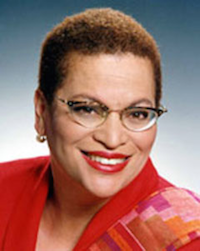July 17, 2015

Julianne Malveaux, NNPA Columnist
After a spirited debate, the South Carolina House and Senate voted overwhelmingly to remove the Confederate battle flag from Statehouse grounds at the urging of Gov. Nikki Haley, who quickly signed the measure into law. The flag was lowered for the final time on Capitol grounds Friday morning. Many South Carolinians hailed its ceremonious removal as a “new day” for their state as well as a fitting tribute to State Senator Clementa Pinckney, one of the nine massacred at Emanuel A.M.E. Church, where he was the pastor.
Revulsion from the Bible study slaughter sparked conversations all over the country about the Confederate flag. An Iowan who sold ice to Walmart with a confederate logo (go figure) was told he had to change his logo or sell his ice elsewhere. The U.S. House of Representatives has banned display of the Confederate flag on sites maintained by the National Park Service. Mississippi Senators Thad Cochran and Roger Wicker say the Mississippi flag should be redesigned to remove the Confederate symbol.
At the same time, support for the Confederate flag is unwavering. A poll conducted for CNN found that 66 percent of Whites consider the Confederate flag more of a symbol of Southern pride than racism, a view shared by only 17 percent of Blacks. While 72 percent of Blacks consider the flag a symbol of racism, only 25 percent of Whites agree, with the remainder of them saying the flag represent each point of view equally, were undecided or expressed no opinion.
Removing the flag from public places and putting it in museums is a victory for those who reject this symbol of racial subjugation. Still, every economic statistic screams racial subjugation. President Obama had it right (if belatedly) when he said that employers are more willing to employ Johnny than Jamal. Last month, the Bureau of Labor Statistics (BLS) reported that Black unemployment rate was 9.5 percent, more than twice the 4.6 percent rate than Whites experienced. Some economists will say that African Americans are less educated than Whites, explaining part of the unemployment rate gap. Others will cite other factors, such as occupation and location. Race still plays a role in unemployment rate differentials.
White men and White high school dropouts have about the same unemployment rate as Black high school graduates, and highly educated Blacks always have higher unemployment rates than less well educated Whites. While education pays off for Blacks, as those with better educations are paid more than those with less education, Whites get a greater return on education than Blacks.
If we want to remove vestiges of racial subjugation, we ought to pay attention to unemployment rate differentials and work as hard to eradicate them as we did to take down that Confederate flag in South Carolina. How? President Obama could sign an executive order directing the Department of Labor and other federal departments to target money and programs to the inner city or, more specifically, to African Americans. In these closing months of his presidency, he has used executive orders for other purposes. Why not use one to ensure that Jamal gets treated the same way as Johnny?
In addition to Jamal and Johnny, how about Tamika and Theresa? Though the unemployment rate gap is smaller between Black and White women, there are gaps in pay and working conditions. Because more than 40 percent of Black families are female-headed, low pay for Black women translate to different living conditions for Black families.
Similar differences are measured in the poverty rate, where more than a quarter of Black families live in poverty, compared to fewer than 10 percent of White families. Average pay for an African American family is about $31,000, compared to about $52,000 for White families. Congress has been hostile to any poverty-prevention programs, fighting to reduce food stamps programs and pushing back on Obama-backed legislation to increase the minimum wage. In the midst of legislative hostility, could President Obama do anything to lower poverty and especially the gap in the poverty rate? Certainly appointing a Presidential Commission to propose legislation on poverty prevention would be a first, if only symbolic.
The wealth gap is staggering. African Americans have a scant 2.5 percent of our nation’s wealth. The median wealth for White families is $120,000, compared to $7,000 for Black families. The wealth gap is partly a function of the inability for African Americans to attain wealth, certainly during slavery and the Black Codes era, and beyond. There were exceptions, of course, but the gaping wealth gap affects the quality of life for African Americans. What to do? The president might consider the Institute of the Black World’s proposal for a John Hope Franklin Commission for Reparatory Justice to explore the possibility of, among other things, reparations.
Taking down the Confederate flag without tearing down the walls of racial economic inequality is a partial victory. While I am elated that South Carolina Gov. Nikki Haley has expressed her opposition to the Confederate flag as a symbol of hate and White supremacy, I wonder if she will fight to end the institutional racism that results in higher unemployment rates, lower incomes, and less wealth for African Americans.
Julianne Malveaux is an author and economist. She can be reached at www.juliannemalveaux.com.

